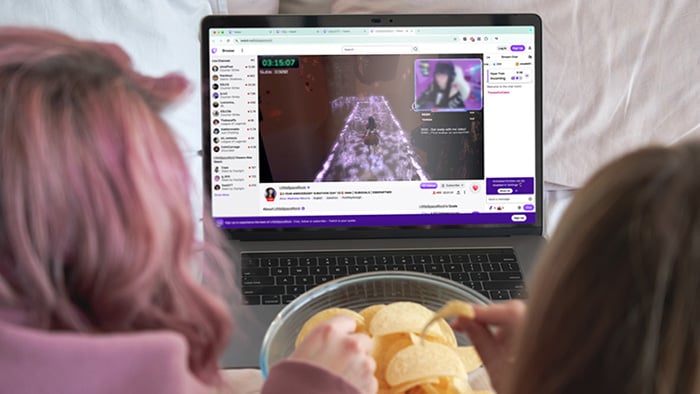- Security
- Privacy
- Performance
What is Internet Streaming and How Does it Work?
What is streaming? Internet streaming allows you to watch videos, listen to music, and even view live events on your computer, laptop, smartphone, tablet, or a smart television that is connected to the Internet. Streaming technology opens up a world of new entertainment and information sources.

Written by
Alfred Poor
Published on September 28, 2019
Published on September 28, 2019
This Article Contains
This Article Contains
What does streaming mean, exactly?
Streaming is a type of media technology that delivers video and audio content to your Internet-connected device. This lets you access content (TV, movies, music, podcasts) at any time you want, on a computer or mobile device, without regard to a provider’s schedule.
Streaming is a major force for change in how we access media content. Not so long ago, we all had to rely on broadcast services to get our news and entertainment. We used radios and televisions to receive whatever a station chose to broadcast, and we listened to the programs that they chose to send on their schedule.
That all changed with the internet. Now we can consume the music, news, TV shows and movies we want, whenever we want and wherever we want. And we can do it from just about any device that we want: smartphone, tablet, computer, and even television sets.
All of this has been made possible by streaming. Streaming technology marks a fundamental difference in how content is distributed. It makes it easy for you to watch a movie on your computer or to listen to a podcast on your mobile phone whenever you feel like it. Best of all, you don’t have to know anything special to stream a movie; it’s available at the touch of a button.
Streaming vs. broadcasting: what's the difference?
Broadcasting typically refers to a single base station that uses radio waves to send out a signal that is captured by receivers tuned to that signal. Every receiver gets the same information at the same time. That is why you have to consult a schedule to learn at what time a given show is available. In other words, a single source distributes to multiple outlets at a single time.
In contrast, streaming refers to a single source sending content to a single destination over a digital connection (such as the internet). This same information can also be sent to other destinations even if they request that the content starts at a different time. As a result, multiple destinations can access the content on their own schedule.
A typical cable television service provides both distribution types. Scheduled programming, such as news shows or live sports events, are broadcast to many homes at the same time; you can choose to watch them when the shows are available. Many cable services also allow you to “record” a show, so you can watch the Kansas City Royals game later, at your convenience; the content (here, a baseball game) is streamed to your television when you request to play it.
With hundreds of thousands of sources for media content on the internet, you can stream content for whatever interests you. From cats to cooking, from politics to polo, from wine to woodworking, there is something for everyone on the internet, available all the time. In fact, you can access so much content through various streaming services that many people have chosen to “cut the cord,” canceling expensive cable or satellite TV subscriptions and relying only on streaming content.
Streaming vs. downloading: what's the difference?
Streaming is different from downloading in several important ways. Downloading means transferring files from a source to your own computer (or other type of device). This process results in a file that is saved on your computer.
As with streaming, you can access a downloaded file whenever you want. Unlike streaming, you don’t need an active internet connection to access the file once it is downloaded.
On the other hand, when you download a file, you have to have enough storage available to hold the entire file. A typical movie in high definition (HD) consumes about 4 GB to 5 GB of space on a computer hard disk or a mobile device. That can fill up the storage on the device quite quickly. In contrast, if you stream a movie, you don’t have to store the file, so you don’t need all that storage capacity.
Another problem with downloading is that you generally cannot start watching or listening to a file until it finishes downloading. This is not a problem if you have a fast broadband internet connection, but it can be frustrating on a slower service. A typical HD movie can take nine minutes to download with a 50 Mbps connection, but that becomes almost an hour and a quarter with a 5 Mbps service.

Broadcasting vs. Streaming vs. Downloading
How does streaming work?
So how does streaming technology actually work? In broadcast media, the sounds and images are encoded into radio waves and then decoded by the radio or television receivers. Streaming on the internet works differently.
There is not a single open channel between the source and the destination. Instead, the source bundles up the data in small packets and sends them via the internet. This is similar to what happens when you send an email or post something on a website. These individual packets can travel at different rates from the source to your device. Each one is labeled so that your device can arrange them in the correct order.
Once your device has enough of these packets lined up and ready to play, it starts to stream the content. This process is known as buffering. If your internet connection is not fast enough to get the packets in time before they’re needed, your content may not play correctly. (See “Problems with Streaming” below.)
Note that buffering is different from progressive downloading. That term refers to some downloads that let you start playing the content before the file is completely saved. You still have to store the entire file on your device, and you can run into similar problems if the data does not download as rapidly as it is used in the playback.
Types of internet streaming
You can listen to or watch just about anything using streaming technology. Many services provide free access, while others may require a paid subscription or other fee. You can find different types of streaming services available for live events, video and movies, music, and games.
Live streaming
Live streaming gives you access to events as they happen. Professional sports are some of the most popular live streaming events, but this category also includes radio broadcasts and live videos on social media channels such as Facebook.
For example, Super Bowl LII had as many as 3.1 million streaming viewers at one time, with an average online audience of 2 million. That American football game is one of the most-streamed sporting events, but the audience was tiny compared to traditional broadcasting: 100 million more viewers watched the broadcast version.
How does live video streaming work?
Live streaming works simply enough: You tune in to a source that’s broadcasting the event. You often can find live streams for breaking political news, music concerts, and interactive social media events. You can even find sources that provide live streams of broadcast radio and television stations from across the U.S. and around the world.
Video streaming
The most popular content for streaming is video. Whether the video is provided in short snippets or in the form of full-length feature films, the best way to watch is using a streaming service. YouTube is the most familiar source for video; people watch about 5 billion videos every day on YouTube. And 300 hours of new content are uploaded to the site every minute.
Geo-blocking refers to systems that control location-based access to content. This location-specific control is put in place for copyright and other reasons. For example, some services license the rights to show a certain movie to U.S. audiences, but cannot show it to people in Europe (or vice versa).
You can work around geo-blocking in some instances by using a virtual private network (VPN). A VPN can provide you with a more secure internet connection, and it has the bonus benefit of making it appear that your connection originates in some other location. For example, if you subscribe to a video streaming service in the U.S. you may not be able to access it when you are traveling in other countries. You may be able to use Avast SecureLine VPN to access the content you have paid for even when outside the U.S.
How does video streaming work?
Video streaming is a form of “store and forward” data access. This means that the files are stored on a server that you can access on demand whenever you want. Many people can access the same content at the same time, but each one can start and stop what they are watching without affecting anyone else. Some services — such as Netflix and Hulu — charge a subscription fee for access, while YouTube and others let you access the content for free, with advertising paying their bills.
Music streaming
It is easy to listen to music from streaming services, both free and subscription-based. All you need to do is sign up with a site such as Apple Music or Spotify. You can quickly find music by a specific artist if you know what you want to hear, or you can select a genre to discover new tracks. Some music streaming sites offer suggestions based on your previous listening habits and the songs you said you like.
Music streaming has changed the listening habits of millions of people. After reaching peak sales of 943 million units in 2000, U.S. music CD unit sales plummeted to just 52 million copies in 2018. Initially, people bought and downloaded MP3 files, but these too have declined. According to BuzzAngle Music, digital sales in the U.S. dropped more than 28 percent in a year, from more than 628 million units in 2017 to about 450 million units in 2018.
The reason? Streaming audio. In that same period, on-demand streams increased from nearly 600 million units to more than 800 million, an increase of more than one-third in just one year. According to the RIAA, streaming music now accounts for 75 percent of total revenues in the U.S. for recorded music.
How does music streaming work?
Like video, music services store recording files so that you can access them whenever you want. Some are available for free, supported by advertising, such as Pandora and Spotify. These services also offer ad-free premium subscription options.
Streaming sound services are not limited to music. You can also listen to podcasts and audio books, as well as live streams of radio stations around the world.
Streaming games and apps
You can also stream interactive video games. Originally, you had to purchase a game on physical media, then play it or install it on your video game console or computer. Physical games sales have since yielded to game downloads, but you still had to play them on your local device — and use up more of your precious hard disk storage.
Now you can stream and play games of your choice from an entire library. You can purchase a single title or pay a subscription to access a wide range of games. You can play on your computer, tablet, or smartphone — wherever you have an internet connection.
The choice of games ranges from simple puzzles and action games, right up to the top-ranked best-selling games available. There are game-streaming services for those who want to explore, as well as individual vendors with their own streaming game sites.
How do streaming games work?
When you stream games or apps, your device becomes a remote terminal for the program. This means that in addition to receiving data such as images and sounds, your device also sends data to the server. This includes game controller inputs that you use to control your character in the game.
There are game services that allow you to play all sorts of games. As with video and music, some require a subscription while others are supported by advertising.
Popular streaming sites and services
Whether you’re just getting started with streaming or already have some favorite services, here are some of the most popular choices available:
For video streaming, YouTube remains the top dog. It offers everything from short-form videos to full-length movies. It includes video podcasts and how-to videos on just about any topic. You may not know that YouTube also streams live content, including news and sports. You can even host your own live video streams on YouTube.
Netflix is the leading subscription site for streaming movies and TV show episodes, but Amazon and Hulu also offer many choices. Roku offers access to a huge assortment of free and subscription channels, including premium TV channels such as HBO and Showtime.
The choices for streaming music and podcasts are nearly endless. Apple’s iTunes is a leading source, but Amazon Music and Slacker are also good choices. Spotify is great if you know what you want to listen to, and Pandora is a good way to discover new artists and tracks that you might enjoy. And TuneIn Radio provides access to curated music collections as well as live audio streams from hundreds of radio and television stations.
For gaming, Sony and Microsoft both have streaming services that let you play games on your PC as well as on their PlayStation and Xbox game consoles. Jump is another subscription service that lets you play games on a variety of computer platforms. The big disrupter, Google’s Stadia, is slated to go live in late 2019, and it promises to provide access to many of the most popular games.
The benefits of streaming
Internet streaming has revolutionized how we consume media. Whether we are checking the latest news, listening to our favorite music artists, or just taking a break with cute puppy videos, we can connect anywhere and anytime using our computers, tablets, or smartphones.
You can start watching or listening almost instantly, without waiting for a large file to download. And since you are not storing files on your device, there is much less risk of running out of room or of putting some malicious code on your device.
In addition, streaming lets you watch events live as they happen, without waiting for the data to be stored first and then made available.
From cord-cutting to the demise of the audio CD, internet streaming has changed how we interact with media of all sorts.
The problems with streaming
Streaming media on the internet may be wonderful, but there are still some things to watch out for.
As mentioned earlier, buffering can be an issue. If the data arrives at your device slower than it plays, you will have problems with the stream stopping and starting, because the system has to pause for the data to catch up. For example, Netflix recommends that you have at least 5 Mbit/s internet service in order to stream movies in high definition. If your connection is slower than that, Netflix lowers the image resolution to avoid buffering, but that is not the case with all streaming services. Fortunately, there are some steps you can take to
Any time you access information online, you need to be concerned about security. You don’t have reason to worry about the major services such as Amazon or Netflix. However, you may run some risk using other sites, so to be safe you should consider using a good anti-malware tool such as Avast Free Antivirus to protect your device and your data.
As mentioned earlier, you may not be able to access all the content you want because it may not be available at your location. You can solve this — and provide extra security for your connection — by using a virtual private network like Avast SecureLine VPN.
Stream Smarter with a VPN
Avast SecureLine VPN for Windows makes your streaming and surfing secure and private. Everywhere you go.
Stream Smarter with a VPN
Avast SecureLine VPN for Mac makes your streaming and surfing secure and private. Everywhere you go.
Stream Smarter with a VPN
Avast SecureLine VPN for Android makes your streaming and surfing secure and private. Everywhere you go.
Stream Smarter with a VPN
Avast SecureLine VPN for iOS makes your streaming and surfing secure and private. Everywhere you go.
This Article Contains:
More Privacy Articles
Stream privately on your Android with Avast SecureLine VPN
Avast
SecureLine VPN
Stream privately on your iPhone with Avast SecureLine VPN
Avast
SecureLine VPN
Streaming
Privacy
Alfred Poor
28-09-2019





